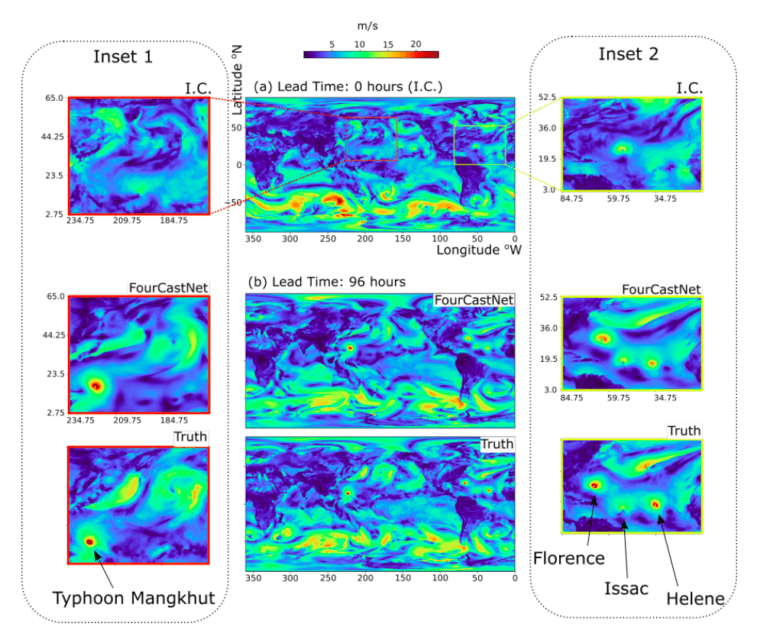TL;DR:
- FourCastNet is a groundbreaking global data-driven weather forecasting model.
- Numerical weather prediction (NWP) has evolved over decades, aided by improved computational power and better data assimilation.
- Data-driven deep learning (DL) models are gaining popularity due to their cost-effectiveness and accuracy.
- FourCastNet offers forecasts at a 0.25 resolution, matching the state-of-the-art numerical weather models.
- It was developed collaboratively by leading institutions, including NVIDIA Corporation and academic partners.
Main AI News:
In the ever-evolving landscape of weather forecasting, FourCastNet emerges as a game-changer, ushering in a new era of accuracy and efficiency. This global data-driven weather forecasting model is set to reshape the way we predict weather patterns, offering unparalleled precision through a cutting-edge deep learning approach. In this business magazine feature, we delve into the transformative journey of FourCastNet and its potential to redefine the industry.
The Birth of Numerical Weather Prediction
The roots of numerical weather prediction (NWP) can be traced back to the 1920s. Since then, NWP has become an integral part of various industries, including transportation, logistics, agriculture, and energy production. Accurate weather predictions have not only saved numerous lives but have also played a crucial role in economic planning. However, the journey to precision was far from swift.
A Glimpse into the Past
In 1922, Lewis Fry Richardson embarked on a groundbreaking journey using nothing but a slide rule and a table of logarithms. His mission is to calculate the first dynamically modeled numerical weather prediction for a single location. Remarkably, it took him six painstaking weeks to produce a mere 6-hour forecast of the atmosphere. Fast forward to the 1950s, where early electronic computers came to the rescue, significantly accelerating forecasting speeds and making operational predictions a reality.
The Evolution of Weather Forecasting
Over the decades, weather forecasting has seen remarkable improvements, owing not only to enhanced computational power but also to a deeper understanding of small-scale phenomena and superior atmospheric observations. The assimilation of data has paved the way for better model initializations, driving the quest for precision even further.
The Rise of Data-Driven Models
In recent years, a revolutionary shift has occurred in weather forecasting, thanks to data-driven Deep Learning (DL) models. These models offer a cost-effective alternative to traditional NWP models and have gained popularity for their efficiency and accuracy. Researchers have harnessed climate model outputs, general circulation models, and reanalysis products to train data-driven models, eliminating biases and enabling large ensembles for probabilistic forecasting.
The Power of Data-Driven Precision
Data-driven models hold immense potential in enhancing weather forecasts. By training on reanalysis data or observations, they circumvent constraints in NWP models and produce forecasts at lightning speed. Research has shown that large data-driven ensembles outperform traditional NWP models, particularly in subseasonal-to-seasonal forecasts.
The Resolution Challenge
One critical aspect of data-driven weather models is the resolution of the data used for training. While low-resolution data has been successful for some atmospheric variables, it often lacks the fine-scale physical information necessary for accurate predictions. To truly excel, data-driven models must match or surpass the resolution of state-of-the-art numerical weather models.
The Birth of FourCastNet
Enter FourCastNet, a Fourier-based neural network forecasting model, developed by a collaborative effort from leading institutions, including NVIDIA Corporation, Lawrence Berkeley, Rice University, University of Michigan, California Institute of Technology, and Purdue University. FourCastNet breaks barriers by delivering global data-driven forecasts of crucial atmospheric variables at an impressive resolution of 0.25, equivalent to approximately 30 kilometers near the equator, with a global grid size of 720×1440 pixels.
A New Frontier in Weather Forecasting
With FourCastNet, we stand on the brink of a new era in weather forecasting. Its high-resolution capabilities promise to revolutionize our understanding of weather patterns and their impact on our world. As we embark on this journey, we invite you to witness the future of weather prediction, where precision meets innovation and the skies are never the limit.
Conclusion:
FourCastNet represents a significant leap forward in the field of weather forecasting. Its high-resolution capabilities and data-driven precision have the potential to disrupt the market, offering more accurate and timely weather predictions that can benefit industries such as transportation, logistics, agriculture, and energy production. Businesses that rely on weather forecasts should closely monitor the impact of FourCastNet on their operations and adapt accordingly to leverage its potential advantages.

